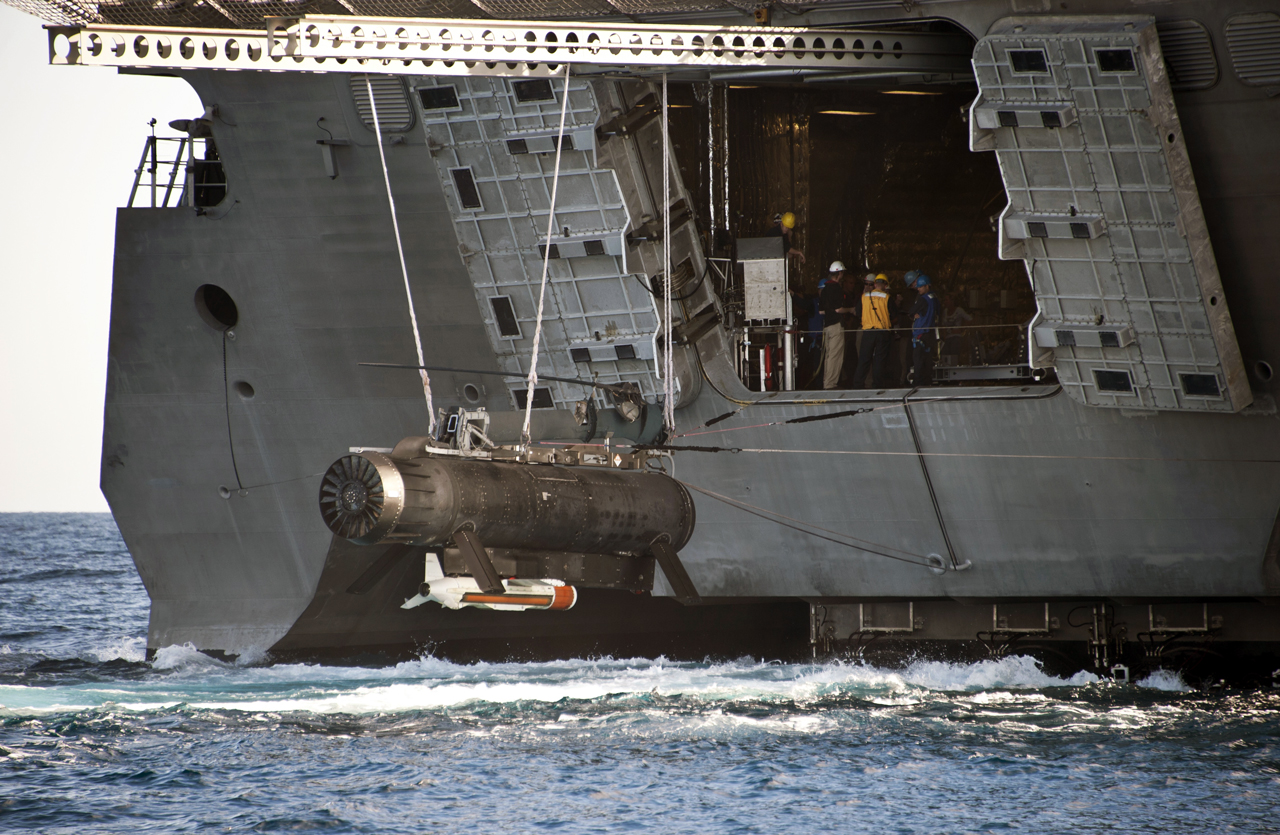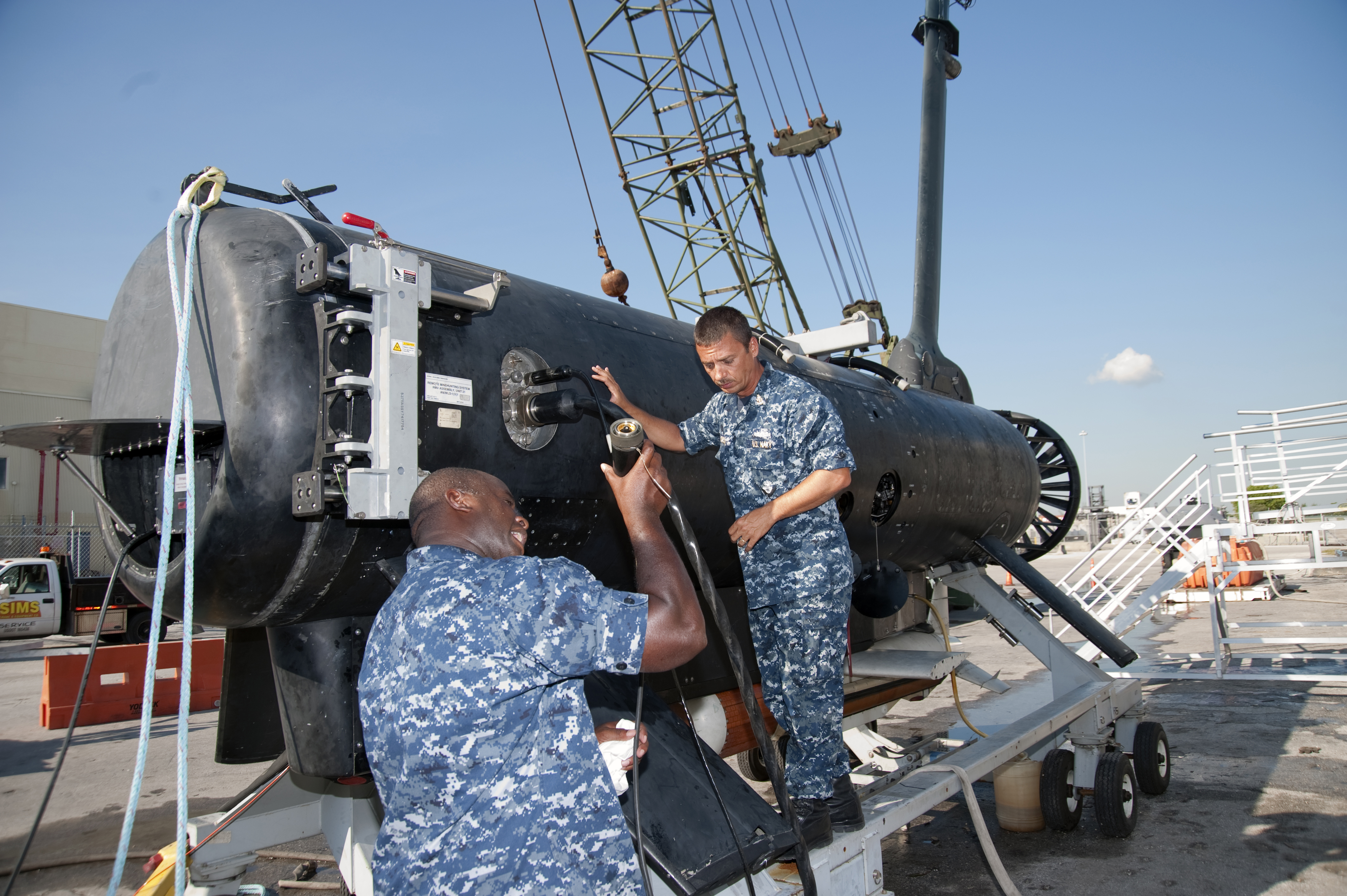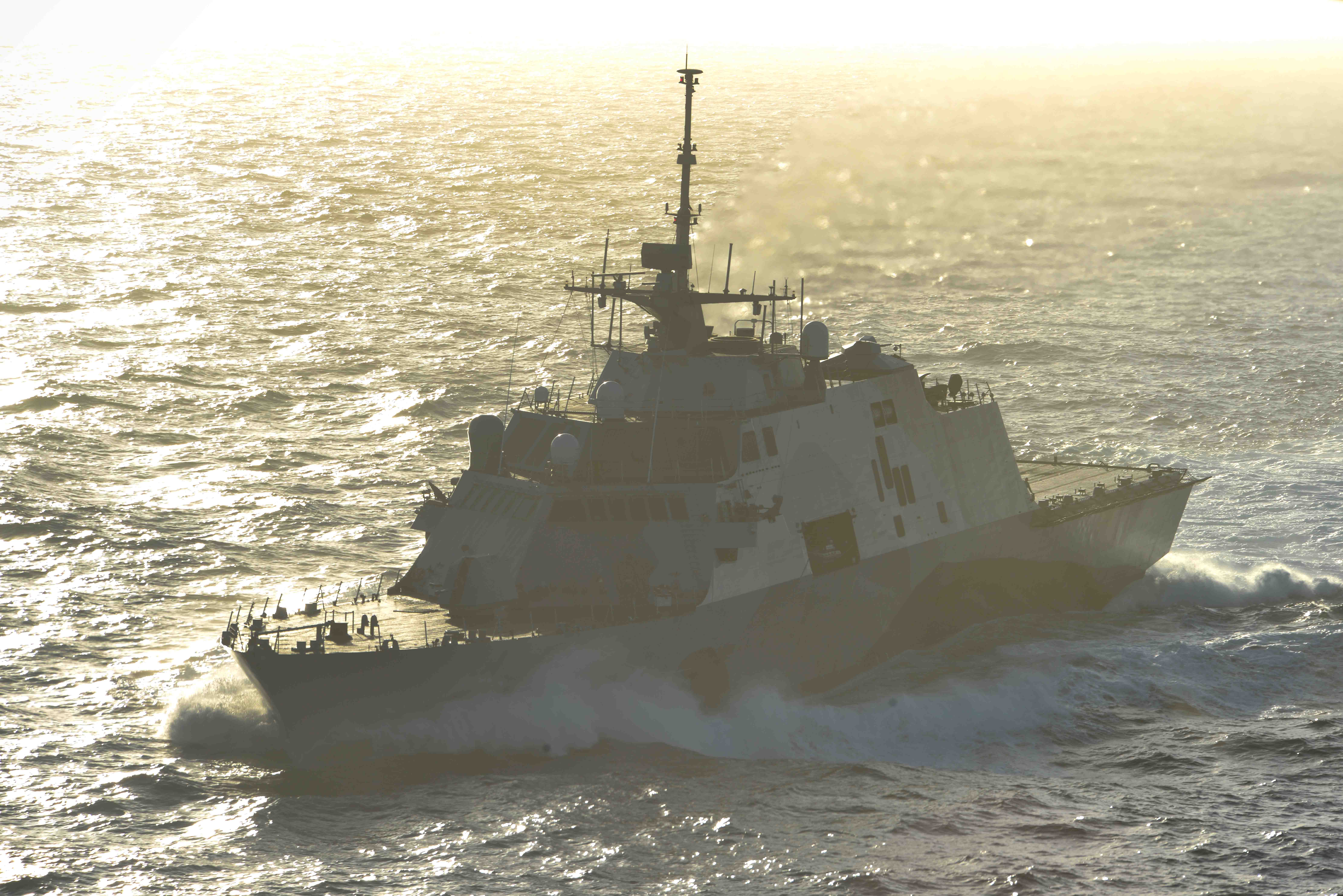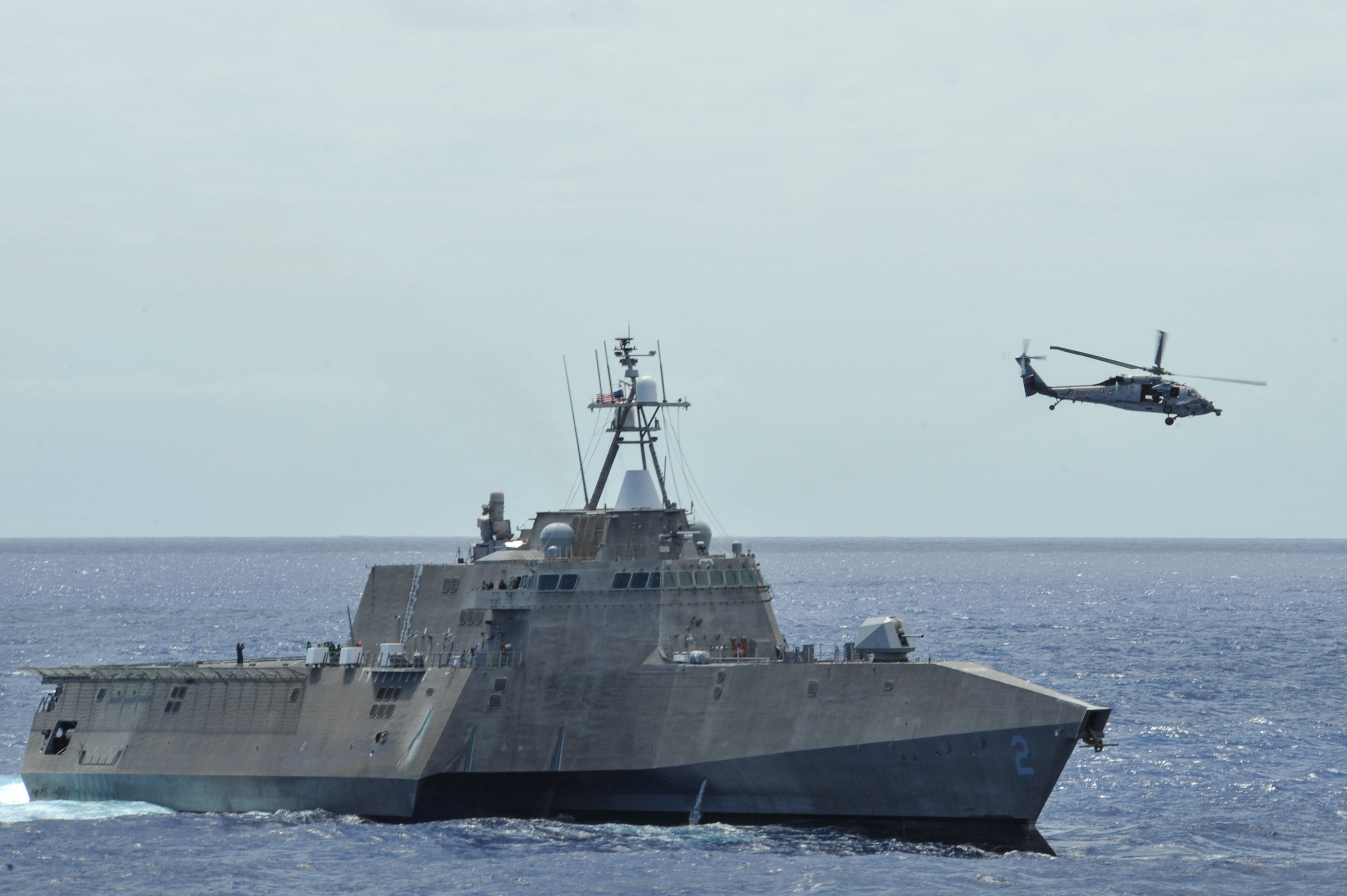
Though the Littoral Combat Ship’s mine countermeasures mission package originally laid out a four-increment fielding plan that made use of three unmanned vehicles, a shakeup in those vehicles’ roles may lead to a single operational test by 2020 that would clear all four increments for use, the Program Executive Officer for LCS told USNI News.
Rear Adm. Brian Antonio said in a May 2 interview that the program office no longer refers to Increments 1 through 4 but instead discusses the volume mine, beach zone, buried mine and mine sweeping capabilities as named rather than numbered increments – and they may end up ready for operational testing at about the same time.
In previous plans, the Lockheed Martin Remote Multimission Vehicle (RMMV) was to tow the AN/AQS-20A sonar for volume search; the Textron Common Unmanned Surface Vehicle (CUSV) would tow a minesweeper, and the General Dynamics Knifefish unmanned underwater vehicle would hunt for buried mines. With the Navy deciding that RMMV as it stands today is too unreliable for its mission, a three-pronged path forward has shaken up planned schedules for all the vehicles in the mission package.
Antonio said that four of the Navy’s 10 RMMVs would be overhauled – given new hoses, belts, electrical components and more – and given to sailors for experimentation.
“We’re going to put them in the hands of the fleet and say, here’s a system, tell us what we can do with it. Use it, see how it is compared to our legacy components and get some usefulness out of it,” he said.
CUSV procurement will be accelerated, he said, “and we’re going to say, okay, we’ve outfitted the system with a Q-20, now go out and see how it finds mines, tell us what you think about it. And not only that, compare it to an RMMV – easier to maintain, harder to maintain; easier to recover, harder to recover; easier to launch, harder to launch; up time, down time, finding mines. We’ll evaluate all that in concert with the fleet.”
Antonio called Knifefish a “very promising system” that had a built-in volume mine search capability in addition to its unique buried mine search sensors. Knifefish fielding is furthest out, but user feedback from the three systems would ultimately get the Navy to a decision in late 2018 or early 2019 regarding which system – or combination of systems – should be used to perform the volume mine search mission on LCSs.
Though each of the four increments of the mission package had its own timeline originally, and each increment would have gone through its own initial operational test and evaluation (IOT&E) with the Pentagon test community, Antonio said the new path forward may lend itself to a single IOT&E that incorporates CUSV in its minesweeping capacity, Knifefish in its buried mine search capacity, and a yet-to-be-determined volume mine search solution – plus the airborne Coastal Battlefield Reconnaissance and Analysis (COBRA) payload conducting beach zone searches.
“We’re already talking with DOT&E (the Director of Operational Test and Evaluation) on what the graduation exercise should look like in terms of the IOT&E for the mission package, and I think it’s a great way to be efficient as well as effective in the testing,” Antonio said, adding that conducting IOT&E in late 2019 or 2020 would still be early enough to let the Navy field the capability before the legacy MCM ships and MH-53E airborne mine countermeasures helicopters retire.

Fleet Input
A final decision on the composition of the MCM mission package would be largely based on what real sailors operating in real-world conditions have to say.
“We learned our lesson with RMMV a little bit. One of the lessons learned, I guess, is [during a reliability growth program] with RMMV we did a lot of testing in the lab, and the numbers were great. Well, what we failed to realize is, the system was being placed in the water with a cradle and it was being towed to the operational area and then it was being lit off and allowed to run; it didn’t go through the whole launch/handling/recovery process on an LCS where it kind of gets bounced around in a seaway and it has to come onboard a ship. So we want to actually put these systems in the hands of the actual operators in real-world scenarios,” Antonio said.
After all the successful lab testing, last summer’s reliability failure off the coast of Florida surprised some in the program.
“During [the technical evaluation], the system – when it was operational – worked like a champ. The whole system found mines – in some cases it found mines it wasn’t supposed to find, it actually went above and beyond – so the system actually worked the way it was supposed to,” he said.
“The issue was reliability. We couldn’t afford to have a machine that would go out into a minefield that was unmanned, thereby taking the sailor out of the minefield, having it break down in the minefield, and oops, now we’re sending a sailor into the minefield to go retrieve the unmanned system. We can’t have that. But let’s face it, we invested a lot of money and a lot of time along the way to have this capability that actually does work when it works – it actually performs when it works.”
Antonio said the LCS program will not make the same mistake again.
“The initial idea is to get (the three unmanned systems) out to 5th Fleet and maybe even 7th Fleet – we’re still working with the fleet commanders on what ships might be available and where the systems can be supported,” he said, noting that those deployments could start as early as 2017. The RMMV, CUSV and Knifefish will also be tested from other ship types and from the shore, increasing sailor familiarity with the systems and feedback the PEO can gather before making a final decision on the mission package composition.

Future Acquisition
The number of mission packages needed is as up in the air as is the composition of those mission packages, Antonio said in the interview, citing several reviews of not only the MCM mission package but also the LCS program as a whole.
Antonio said PEO LCS has bought enough mission packages to support deployments for the next couple of years, but the ship hulls are now delivering at four a year and previous cuts to mission package funding have slowed procurement. The PEO, the surface warfare directorate at the Pentagon (OPNAV N96) and congressional staffers have all been in communication about staying on track with mission package procurement, he said, but the actual procurement goal is likely to change.
“The opportunity moving forward, of course, is as we go to frigate and we come out of the LCS mission modules … the opportunity there is to redefine with our N96 resource sponsor the total number of mission packages and how many systems making up each of those mission packages we need,” Antonio said. The frigate design will have some components of the LCS’s surface warfare and anti-submarine warfare mission packages permanently built into the ship, rather than included in swappable packages.
Antonio said the Navy had a pretty good idea before of how the planned 52 LCSs would operate, and where, and with what mission packages. But since the 2014 decision to move mid-program to a frigate design, those assumptions have to be revisited.
All told, he said, the Navy does not currently have a stated goal for how many mission packages to buy or how many components within the mission packages to buy.

Anti-Submarine Warfare Mission Package
Though less talked about than its MCM counterpart, the anti-submarine warfare (ASW) mission package is coming along nicely, Antonio said. The PEO is working with three contractors to come up with concept designs for an engineering development model (EDM), and “we’ll go forward with one, two or three of those contractors to then continue to pursue and get into a risk reduction phase.”
Antonio said it would be important to test the EDM with real sailors in the fleet, same as the MCM package. In some ways, there is more at stake in selecting the ASW package – particularly the variable-depth sonar within the mission package – and the PEO needs to get it right.
“I think it’s going to be kind of game changing technology to be able to get a variable-depth sonar. We want to make sure we’re doing this right in terms of the decision because this is a decision that not only affects LCS and frigate for the next 25 years, it’ll be the variable depth sonar solution probably for the Navy, so we want to make sure that we get all the aspects of it right,” Antonio said.
This mission package is on track for initial operational capability in late 2017 or the first quarter of 2018, Antonio said, with the Navy primarily working on risk-assessment and risk-mitigation right now.
“We don’t want to wind up with a system that … has a known risk that we haven’t been able to at least put a boundary around,” he said, and the program office is keeping busy “trying to keep things on track while still engaging the contractors to take a look at individual component risks and retire those before moving forward.”





